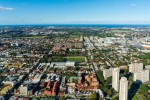Beyond the Storm: A Complete Post-Typhoon Recovery Guide for Filipino Families and Communities
Every year, the Philippines braces for multiple typhoons that leave behind a trail of destruction—damaged homes, flooded barangays, interrupted livelihoods, and displaced families. While Disaster Preparedness Month (July) reminds us how to prepare before calamities strike, what often gets overlooked is what comes next—the recovery process.
The days and weeks after a typhoon are crucial. Families and communities face not only physical damage but also emotional, financial, and health challenges. Post-typhoon recovery isn’t just about repairing what was broken—it’s about rebuilding stronger, safer, and more resilient lives.
This blog serves as a comprehensive guide for Filipino families and communities on how to navigate recovery after a storm.
1. Immediate Safety First: Protecting Lives Before Property
After a typhoon passes, safety is the top priority.
✅ Wait for official clearance before going outside. Avoid floodwaters—they may contain sharp objects, chemicals, or diseases like leptospirosis.
✅ Turn off electricity before inspecting your home for water damage to prevent electrocution.
✅ Check for structural hazards. Weak walls, cracked roofs, or fallen power lines can cause accidents.
✅ Use protective gear. Gloves, boots, and masks reduce the risk of cuts, infections, and respiratory problems.
Community Tip: Barangays should deploy rapid assessment teams to check major hazards like downed wires, blocked roads, and damaged bridges before residents return to normal movement.
2. Checking on Family and Neighbors
After ensuring your household’s safety, extend help to others.
Family First: Check everyone for injuries and provide first aid before heading to hospitals (if accessible).
Neighbors Next: Elderly, PWDs, and solo parents may need urgent help. Communities recover faster when neighbors work together.
Stay Informed: Use radios, government updates, or verified online sources for announcements on relief distribution, evacuation orders, or weather advisories.
3. Cleaning Up Safely and Effectively
The aftermath often involves mud, debris, and damaged belongings.
-
Wear protection: Boots and gloves prevent cuts and infections.
-
Segregate waste: Separate biodegradable, non-biodegradable, and hazardous (like batteries, chemicals).
-
Sanitize water containers and utensils. Contaminated water can spread diarrhea, cholera, and other diseases.
-
Dry soaked belongings immediately to prevent mold and foul odor.
Community Tip: Organize bayanihan clean-up drives—barangays can assign zones, making the process faster and fostering community spirit.
4. Health and Well-Being: Preventing Secondary Disasters
Typhoons often cause outbreaks of illness due to stagnant water, spoiled food, and poor sanitation.
-
Water Safety: Boil water before drinking or use purification tablets.
-
Food Safety: Discard spoiled or water-exposed food.
-
Mosquito Control: Clear stagnant water to prevent dengue.
-
Mental Health: Typhoons cause trauma. Encourage children and adults to express feelings. Barangays can organize debriefing sessions with volunteer health workers.
5. Rebuilding Homes and Infrastructure
Recovery involves making homes more resilient.
-
Assess damage first: Prioritize repairs that ensure safety (roof, foundation, walls).
-
Use stronger materials for rebuilding when possible.
-
Elevate electrical outlets to reduce future flood risk.
-
Apply for government assistance (DSWD, LGU, PAG-IBIG calamity loans, DPWH programs).
Community Tip: Encourage community rebuilding projects where carpenters and skilled workers help neighbors reconstruct damaged homes.
6. Financial Recovery After a Typhoon
Disasters often drain family resources. To manage finances:
-
List down expenses: Prioritize essentials—food, shelter, medical care.
-
Keep receipts of damages and expenses for insurance or government aid applications.
-
Explore assistance programs:
-
DSWD’s cash-for-work programs
-
PhilHealth coverage for medical emergencies
-
PAG-IBIG calamity loans
-
DA support for farmers and fisherfolk
-
Start small livelihood recovery: Sell cooked food, homegrown produce, or small goods while waiting for bigger income recovery.
7. Strengthening Community Resilience
True recovery isn’t just about rebuilding—it’s about preparing for the next disaster.
-
Barangay Disaster Committees should update community evacuation plans and resources.
-
Community Drills: Regularly practice emergency response.
-
Shared Storage: Have communal stockpiles of rice, canned goods, first aid, and emergency water.
-
Education: Train families on basic first aid, sanitation, and disaster response.
8. Mental and Emotional Healing
Beyond physical recovery, typhoons leave emotional scars.
-
Acknowledge grief: It’s normal to feel sadness or fear after loss.
-
Encourage children: Provide reassurance and routines to restore normalcy.
-
Seek professional help if needed: Many NGOs and government units provide free psychological first aid.
-
Faith and Bayanihan: Many Filipinos find strength in community prayers, church activities, and collective resilience.
9. Moving Forward: Building a Culture of Preparedness
Post-typhoon recovery is more than fixing damage—it’s about creating a culture of preparedness.
Families and communities should:
-
Regularly update go bags and emergency kits.
-
Invest in resilient housing where possible.
-
Practice evacuation drills.
-
Share lessons learned from each disaster.
Every typhoon is a harsh teacher, but it also provides opportunities to become stronger and more united.
The Philippines may be among the most disaster-prone countries in the world, but Filipinos are also among the most resilient. Post-typhoon recovery is not just survival—it’s a journey of rebuilding lives, strengthening communities, and preparing for the future.
Through bayanihan, government support, and proactive family planning, recovery can lead to a stronger and more prepared nation.
Let’s remember:
🌧️ Before the storm: prepare.
🌪️ During the storm: survive.
☀️ After the storm: recover, rebuild, and rise again.




